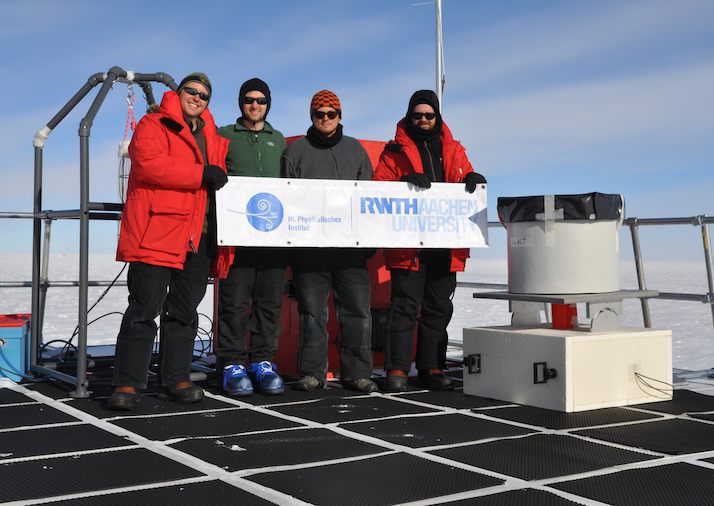Decades ago, the aspiration to build a kilometer-scale neutrino detector at the South Pole seemed farfetched; today, we celebrate the 5-year anniversary of this incredible achievement. Shortly after 6 pm New Zealand time on December 18, 2010, the final sensor was lowered into the ice. This completed the decade-long construction effort that started with the design and fabrication of detector systems and concluded with the installation of the final string of sensors.

Building IceCube in such a remote location came with a special set of challenges. All personnel, equipment, fuel, and detector components had to be transported to Antarctica and then flown in ski-equipped cargo planes to the Pole. Throughout construction, the IceCube team shipped 4.7 million pounds of cargo to the South Pole.

To construct IceCube, dedicated drill teams melted 60-centimeter diameter holes in the ice to a depth of 2,450 meters, deployed sensors, and commissioned strings from November to February each year from 2004 until 2011. A special drill was designed to use hot water at high pressure to efficiently melt through the ice. A separate drill was designed and deployed to advance through the firn layer, the top 50 meters of compacted snow where hot water drilling is not efficient. Together the two drills were able to consistently produce almost perfect vertical holes ready for deployment of instrumentation at a rate of one hole every two days.
Deployment specialists attached 60 sensors to the cable string and lowered them to a final depth of 2,450 meters below the surface in just 11 hours. To maximize the short time available for working at the Pole each season, drilling and deployment teams worked around-the-clock, taking breaks only on Sundays. IceCube took 28,000 person-days, or 78 years of continuous work, to complete.
A dedicated team of physicists, engineers, technicians, IT professionals, and funding partners from around the world made the idea of turning the Antarctic ice into a telescope possible. The team built IceCube on time, on budget, and exceeding performance expectations, which continue to this day. The IceCube Neutrino Observatory is operated by the Wisconsin IceCube Particle Astrophysics Center, WIPAC, at UW–Madison.

This year at the South Pole, the IceCube team has just commissioned the first imaging air Cherenkov telescope prototype called IceAct. This detector will be used for calibration measurements of low-energy muons with IceCube. The IceAct prototype is currently taking background data following its successful installation. Once IceAct is fully integrated and the sun goes below the horizon, it will start recording signals from air showers in coincidence with IceCube. This prototype may also be of interest as a future veto against the cosmic ray background.
In addition to commissioning the IceAct prototype, team members are working to understand and mitigate the impact of snow accumulation on IceTop tanks. One of the major planned upgrades is to install and commission scintillator panels at two IceTop stations in order to restore the efficiency lost due to large snow accumulation.
Regular seasonal work this year includes winterover training, LED flasher calibrations, and network configuration and upgrades. Twowebcasts are planned in January so that students can hear what it is like to live and work at the South Pole.
